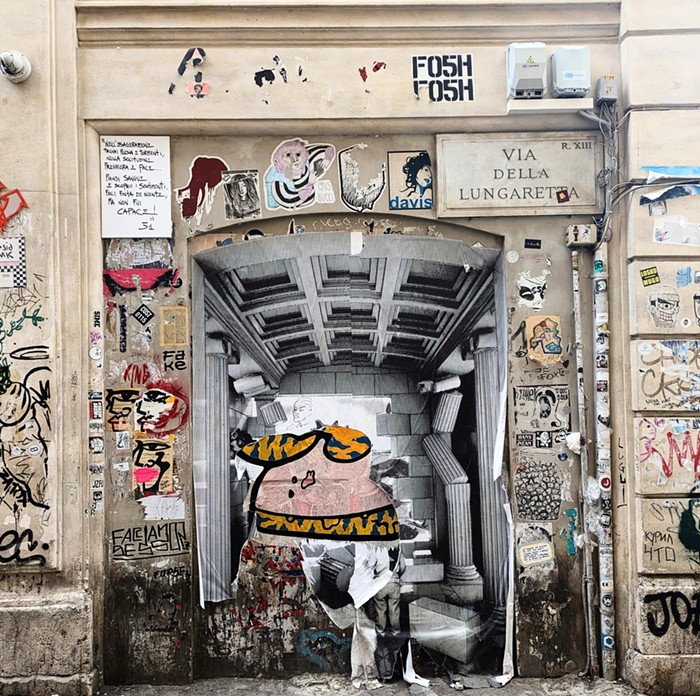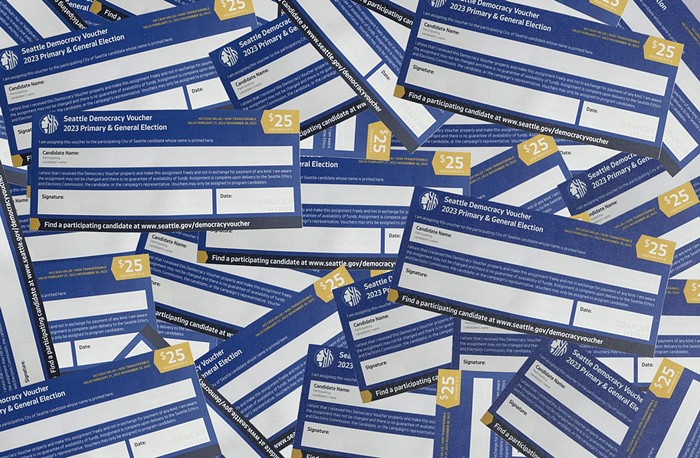322-2018, or www.seattlefringe.org
March 8-18.
Imagine that you're a small theater company doing a technically simple play with four actors and not much scenery. "Why, this is the perfect show to tour the fringe festival circuit!" you exclaim. In good spirits, you begin at the Montreal Fringe Festival and travel westward to Ottawa, Toronto, Winnipeg, Saskatoon, Edmonton--that's a particularly exciting one, attended by 450,000 people each year--Victoria, Calgary, and Vancouver, and you think, "Say--I'll hop down to the Seattle Fringe Festival and round out my trip!" And you go to Seattle....
And you discover there's nothing going on, because it's September and the Seattle Fringe Festival happens in March, before the Canadian circuit even begins (Montreal's festival is in June). Okay, the Seattle festival has finally decided to do something about this by moving the festival to September, starting next year. So let's pretend it's 2002: Yeehah! You're set! You come zooming down to Seattle. Your show is lean and sexy from three months of touring. Audiences are good. You go to collect your box office revenue....
And you discover that you don't get to keep it all, the way you do in the Canadian festivals--the Seattle Fringe Festival instead pays you around 75 percent of the total revenue. The festival administration explains that the Canadian festivals receive up to four times as much government funding as the Seattle festival does; without taking a chunk of the box office, the Seattle festival simply couldn't continue to function. The percentage has been getting better every year, and you commend the Seattle festival for making a consistent effort to pay the artists better. Unfortunately, your budget--which was tight to begin with--is now bursting at the seams.
Let's do some quick math: The maximum possible income for a show in Seattle's Fringe Festival is $12,254. That's seven sold-out performances in a 295-seat theater, minus the participation fee for such a venue. Sounds pretty good for seven days work, right? Unfortunately, there is only one 295-seat theater in the festival--the other nine have 99 seats or less. The maximum possible income for a show in a 99-seat theater is $3,533.80. That's if every performance sells out, and very few shows sell out every performance; big crowds don't flock to performances at, say, 6:00 p.m. on Monday or 11:00 p.m. on Tuesday, and every show gets at least one or two unpopular time slots. Frankly, if a theater company makes $2,000, it's had a very successful show. Out of that $2,000, it has to cover its production and marketing costs and (if it can manage it) pay performers, the stage manager, the director, and the playwright. Break it down and you can see why everyone wants to do self-written solo shows. Add traveling expenses, and the Seattle festival becomes economically unfeasible.
Now imagine that you're a member of the Fringe Festival audience. You've heard of Edmonton and Montreal and how those festivals pull in amazing theater from all over the world. You go to the Seattle festival... and you discover that over 50 percent of the shows are from neophytes; there's only a handful of shows by established local companies who produce year-round (for whatever reason, many Seattle fringe theaters don't take part), and only a smattering of shows from out of state. It hardly seems fair.
Why is the Seattle festival so expensive to put on? Because it uses the Canadian model, in which the festival administration acts as a producer. The Seattle Fringe staff argues that because the Festival doesn't foster the creation of the shows itself, it isn't a producer--but the Festival rents out performance venues, hires people to staff them, runs ticket sales, and provides the most essential marketing tool the festival has: the program guide. If that isn't producing, I don't know what is. This model works in Canada because of the aforementioned government support, which pays for a lot of the festivals' expenses. Without that support, this model works at the expense of the artists.
This, however, is not the only model. Let's suppose that the festival, as an organization, acted as more of a nerve center: The staff provides theater companies with a list of local theaters that have agreed to be performance venues. The companies rent space from the venues themselves, who charge rates that cover the expense of technicians and house staff. The participating companies take their entire box office revenues; the venues make money directly from the rent; both are responsible for setting their own prices. The festival creates the program guide and charges a fee for listings, as well as ad sales.
It's less fair--people who could afford it could get a lot more time and more polished venues--but why should the Fringe Festival be fair? It's more chaotic (prices would vary wildly and there would be no central location to buy tickets), but why should the Fringe Festival be orderly? Fairness and order have little to do with creativity or artistic quality.
It also puts the burden of production on the backs of the participating theater companies. Would this discourage participation? Currently, around 90 theater groups take part in the Seattle festival. Around 150 theater groups take part in the Edmonton Fringe Festival, which also uses the producer model. Around 600 to 650 theater groups take part in the Edinburgh Fringe Festival, which uses the "nerve center" model. Apparently, a greater production burden isn't discouraging at all.
Right now, not only is the festival not scaling back its own production burden, it's making plans for even more programming, including an "Alumni" program in which the festival produces a new show by a previous festival standout and a smaller-scale "new works" festival event (involving a mere 30 participants). The money for these programs comes from more grants-- grants that help to support the festival as an institution, but don't have much to do with improving the festival as an opportunity for artists.
The festival administration won't want to reimagine its structure; institutions dream of growth, not reduction. But in fact, it would be easier for the festival to switch to a different system now than it would have been before, because all of the venues for the festival are existing theater spaces (thankfully, the days of hastily outfitted storefronts and classrooms are gone). Not all of these venues would like this different model, but it might appeal to venues that currently don't take part in the festival.
The "nerve center" model doesn't eliminate financial risk--a good many participants would still lose money, as they currently do. But it does put the full range of decisions about that risk (where to perform, when to perform, how much to charge) into the hands of the artists themselves. This, as much as anything, should be what the Seattle Fringe Festival is about.

















